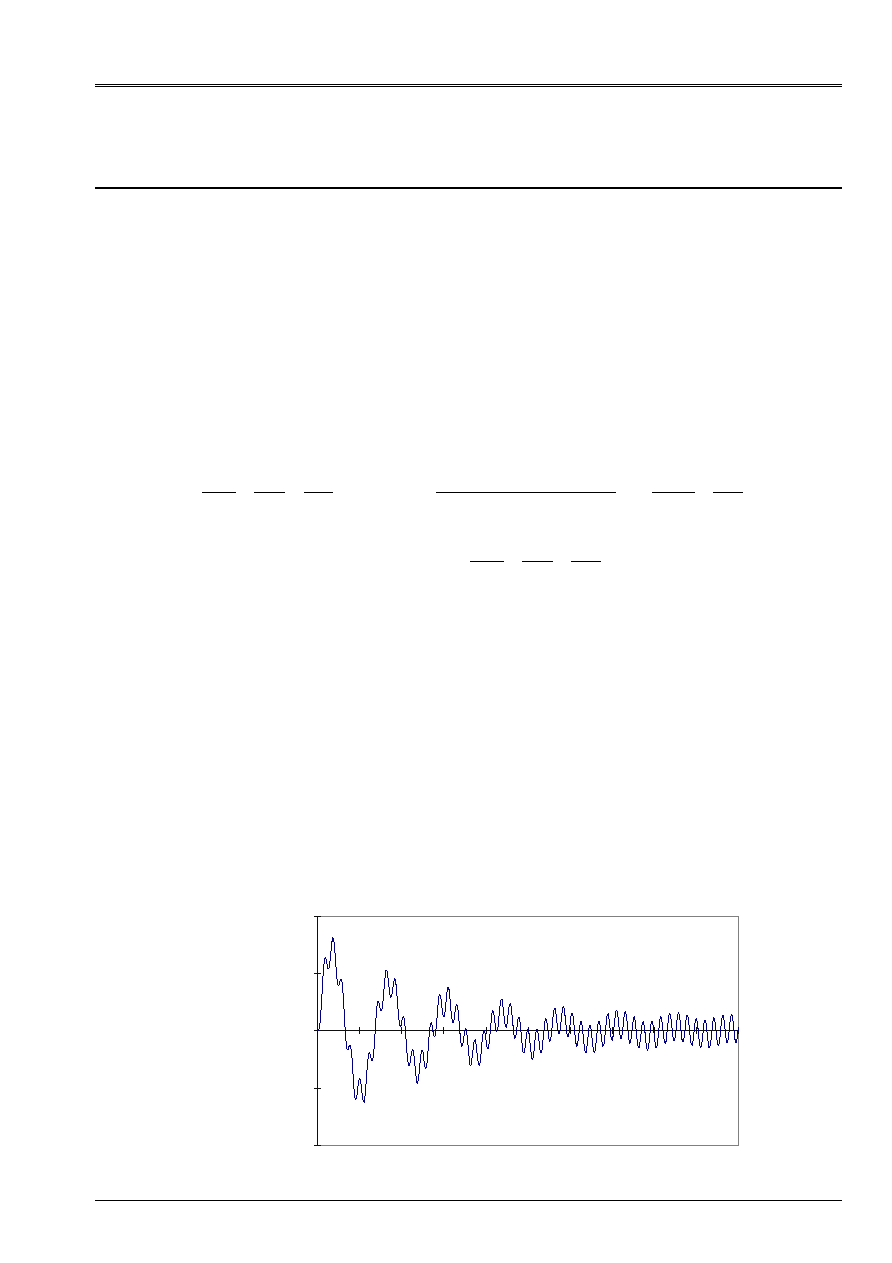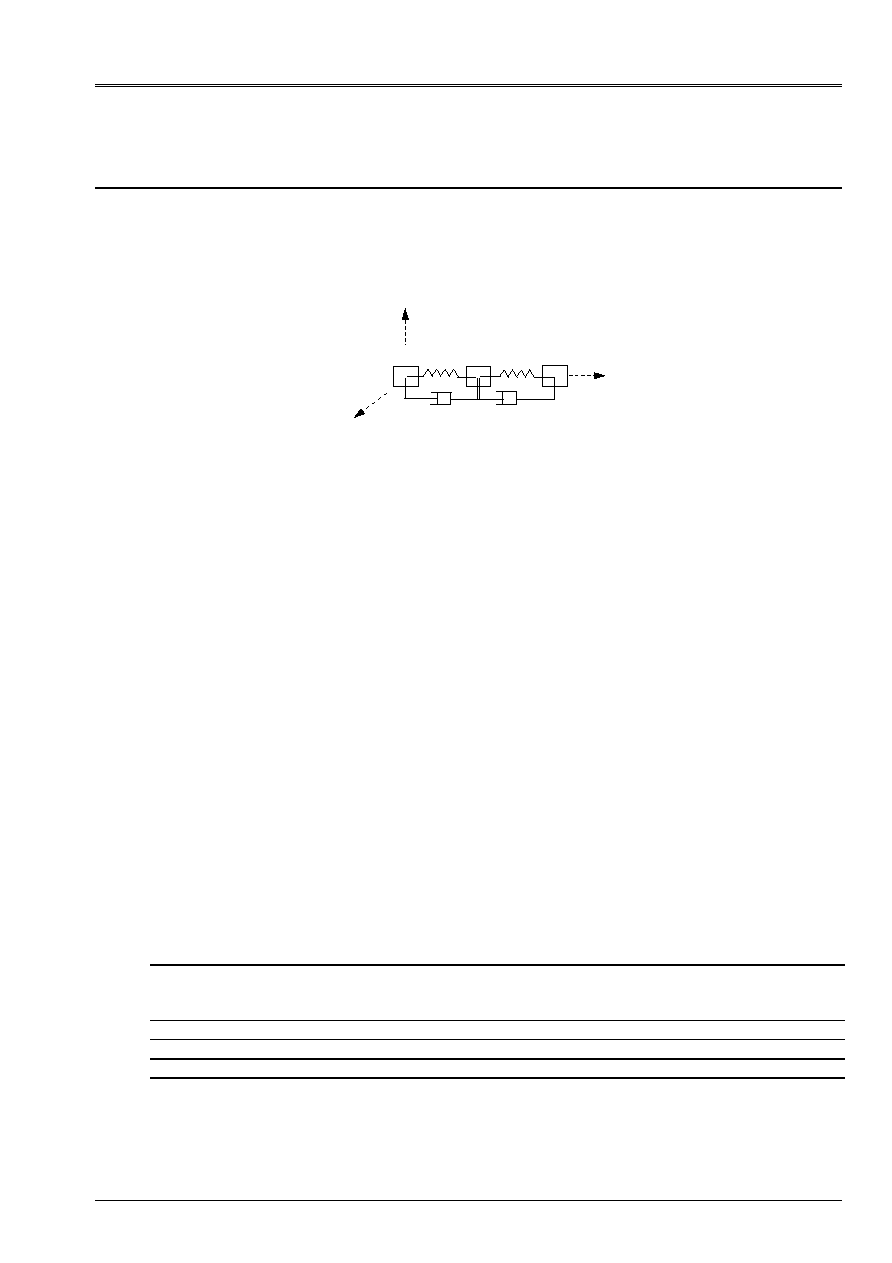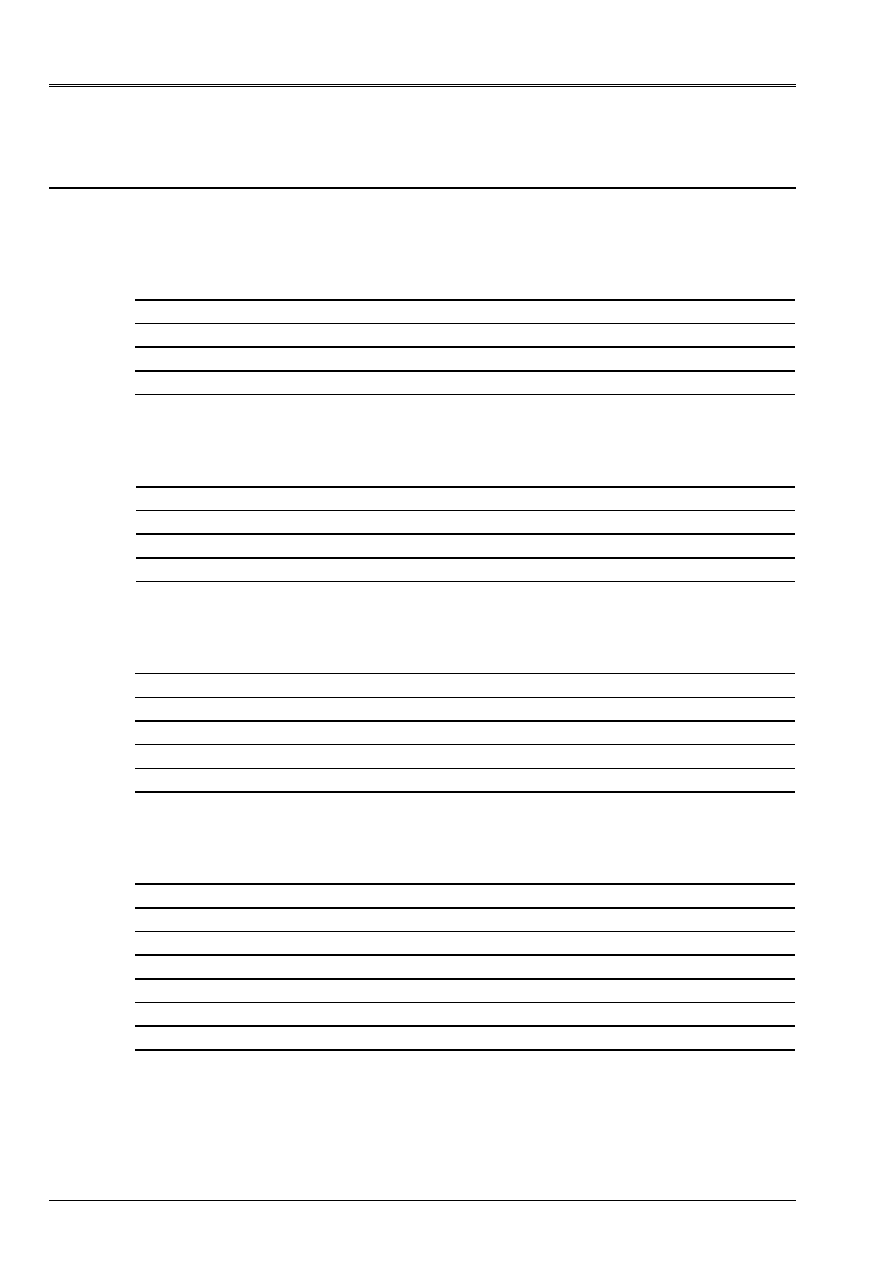
Code_Aster
®
Version
6.4
Titrate:
SDLD320 - Transitory response of a free system of 3 masses and 2 springs
Date:
01/03/04
Author (S):
E. BOYERE, T. QUESNEL
Key
:
V2.01.320-A
Page:
1/8
Manual of Validation
V2.01 booklet: Linear dynamics of the discrete systems
HT-66/04/005/A
Organization (S):
EDF-R & D/AMA, IRCN
Manual of Validation
V2.01 booklet: Linear dynamics of the discrete systems
V2.01.320 document
SDLD320 - Transitory response of a free system
of 3 masses and 2 springs under excitation
harmonic
Summary:
One considers the transitory analysis of a discrete system masses/arises linear with three degrees of freedom
completely free. This system has a non-proportional damping. A sinewave excitation is
applied at an end of the system.
In this problem, one tests, through a discrete model, the calculation of the transitory response of a system
whose rigid modes are not fixed. One is interested only in the transient state. For that, one will seek
the solution by an integration on the modal basis supplements (
DYNA_TRAN_MODAL
[U4.53.21]).
The results obtained (displacement, speed and acceleration) are compared with an average of results
coming from industrial codes and a method of integration numerical of type
- Newmark improved.

Code_Aster
®
Version
6.4
Titrate:
SDLD320 - Transitory response of a free system of 3 masses and 2 springs
Date:
01/03/04
Author (S):
E. BOYERE, T. QUESNEL
Key
:
V2.01.320-A
Page:
2/8
Manual of Validation
V2.01 booklet: Linear dynamics of the discrete systems
HT-66/04/005/A
1
Problem of reference
1.1 Geometry
m
1
m
3
m
2
K
1
K
2
F
0
sin (
T)
C
1
C
2
P
1
P
3
P
2
1.2
Properties of materials
Stiffnesses of connection: K
1
= 4. 10
9
N.m
1
, K
2
= 5.33 10
8
N.m
1
Specific masses: m
1
= 10
6
kg, m
2
= m
3
= 12.10
6
kg
One-way viscous damping: C
1
= 1.2566 10
6
kg.s
1
, C
2
= 9.0478 10
6
kg.s
1
1.3
Boundary conditions and loadings
Completely free system.
Loading at the point P
3
along axis X: F (T) 0=F
0
sin (
T) for T 0 with F
0
= 5.10
4
NR and
=19 rad.s
1
.
1.4 Conditions
initial
The system is at rest with t=0:
()
U 0
0
=
and
()
dt 0
0
=
.

Code_Aster
®
Version
6.4
Titrate:
SDLD320 - Transitory response of a free system of 3 masses and 2 springs
Date:
01/03/04
Author (S):
E. BOYERE, T. QUESNEL
Key
:
V2.01.320-A
Page:
3/8
Manual of Validation
V2.01 booklet: Linear dynamics of the discrete systems
HT-66/04/005/A
2
Reference solution
2.1
Method of calculation used for the reference solution
The search of the transitory response of this problem to damping nonproportional, and where them
rigid modes are not fixed, can be carried out by numerical integration in real space:
[]
{}
[]
{}
[]
{} {}
M U
C U
K U
F
N
N
N
&&
&
+
+
=
.
For that, the answer was calculated with two industrial codes:
·
PERMAS: Diagram of integration of Newmark (
=0,25, =0,5), t=10
4
S,
Diagram of integration with cubic interpolation of Hermit [bib1],
t=10
4
S,
·
ABAQUS: Diagram of integration of Hilber-Hughes-Taylor [bib2] (
=-0,05), t=10
4
S,
and method of integration of
- Newmark improved [bib3]:
[] [] []
{
}
{
} {
} {}
[] []
{
}
[] [] []
{}
M
T
C
T
K
U
F
F
F
M
T
K
U
M
T
C
T
K
U
N
N
N
N
N
N
2
2
2
1
2
1
2
2
3
3
2
3
2
3
+
+
=
+
+
+
-
+ -
+
-
+
+
+
+
where N, n+1, n+2 respectively indicate the calculations carried out at times T
N
, T
n+1
=t
N
+
T and T
n+2
=t
N
+2
T where
T is the increment of appointed time.
To start, one takes:
·
0
0
1
0
U
T
U
U
U
&
-
=
-
and
·
F
F
F
-
=
-
1
0
1
2
The pitch of adopted time is
t=10
- 5
S.
2.2
Results of reference
Displacement, speed and acceleration of the point P
3
.
Differential of displacement enters the points P
3
and P
1
.
Relative displacement of the point P
3
compared to the point P
1
- 1,00E-05
- 5,00E-06
0,00E+00
5,00E-06
1,00E-05
0,0
0,5
1,0
1,5
2,0
2,5
3,0
3,5
4,0
4,5
5,0
time (S)
U
3
- U
1
(m)

Code_Aster
®
Version
6.4
Titrate:
SDLD320 - Transitory response of a free system of 3 masses and 2 springs
Date:
01/03/04
Author (S):
E. BOYERE, T. QUESNEL
Key
:
V2.01.320-A
Page:
4/8
Manual of Validation
V2.01 booklet: Linear dynamics of the discrete systems
HT-66/04/005/A
2.3
Uncertainty on the solution
Average of numerical solutions.
2.4 References
bibliographical
[1]
J.H. ARGYRIS, PC DUNE and T. ANGELOPOULOS “Non-linear oscillations using the
finite technical element “comp. Meth. Appl. Mech. Engng., Vol.2, 1972, pp. 203-254
[2]
H. Mr. HILBER, T.J.R. HUGHES and R.L. TAYLOR “Improved numerical dissipation for time
integration algorithms in structural dynamics “Earthquake Structural Engineering and
Dynamics, Vol.5, 1977, pp. 283-292
[3]
Structural N.M. NEWMARK “A method off computation for dynamics” Proceeding ASCE
J.Eng. Mech. Div E-3, July 1959, pp. 67-94

Code_Aster
®
Version
6.4
Titrate:
SDLD320 - Transitory response of a free system of 3 masses and 2 springs
Date:
01/03/04
Author (S):
E. BOYERE, T. QUESNEL
Key
:
V2.01.320-A
Page:
5/8
Manual of Validation
V2.01 booklet: Linear dynamics of the discrete systems
HT-66/04/005/A
3 Modeling
With
3.1
Characteristics of modeling
Discrete elements of rigidity, damping and mass.
P
1
P
3
P
2
N1
N2
N3
.
.
.
y
X
Z
Characteristics of the elements:
DISCRETE:
nodal masses
M_TR_D_N
rigidities
linear
K_TR_D_L
depreciation
linear
A_TR_D_L
No boundary conditions, in all the nodes: DX, DY, DZ, DRX, DRY, DRZ free.
Names of the nodes: P
1
= N1, P
2
= N2, P
3
= N3.
Method of calculation:
Integration on the modal basis supplements with Newmark (
=0,25, =0,5),
No time:
t=10
- 4
S then modal recombination.
Duration of observation: 5s.
3.2
Characteristics of the mesh
A number of nodes: 3
A number of meshs and type: 2 meshs SEG2
3.3
Functionalities tested
Controls
DISCRETE AFFE_CARA_ELEM
NET
“K_TR_D_L'
NET
“A_TR_D_L'
NODE
“M_TR_D_N'
MODE_ITER_SIMULT
CALC_FREQ
(Option: “CENTER”)
DYNA_TRAN_MODAL NEWMARK
REST_BASE_PHYS NOM_CHAM:“DEPL”
CALC_FONCTION COMB

Code_Aster
®
Version
6.4
Titrate:
SDLD320 - Transitory response of a free system of 3 masses and 2 springs
Date:
01/03/04
Author (S):
E. BOYERE, T. QUESNEL
Key
:
V2.01.320-A
Page:
6/8
Manual of Validation
V2.01 booklet: Linear dynamics of the discrete systems
HT-66/04/005/A
4
Results of modeling A
4.1 Values
tested
·
Displacement of the point P
3
Time Displacement
Displacement
Difference
(S)
Reference
(m)
Aster
(m)
(%)
0,09
6,7395 E-6
6,73326 E-6
- 0,093
0,32
1,1019 E-5
1,10002 E-6
- 0,171
1,18
3,6683 E-5
3,66122 E-5
- 0,193
4,92
1,6615 E-4
1,65849 E-4
- 0,181
·
Speed of the point P
3
Time Speed Speed
Difference
(S)
Reference
(Mr. S
1
)
Aster
(Mr. S
1
)
(%)
0,05
1,3425 E-4
1,34131 E-4
- 0,088
0,32
- 6,4111 E-5
- 6,41097 E-4
- 0,002
1,18
1,6104 E-5
1,60598 E-5
- 0,274
3,55
4,4262 E-5
4,41720 E-5
- 0,203
·
Acceleration of the point P
3
Time Acceleration
Acceleration Difference
(S)
Reference
(Mr. S
2
)
Aster
(Mr. S
2
)
(%)
0,09
- 3,5694 E-3
- 3,56634 E-3
- 0,086
0,18
- 4,3924 E-3
- 4,38933 E-3
- 0,070
0,55
4,3766 E-3
4,37283 E-3
- 0,086
1,18
4,2459 E-3
4,24264 E-3
- 0,077
4,92
- 4,2233 E-3
- 4,21962 E-3
- 0,087
·
Relative displacement of the point P
3
compared to the point P
1
Time U
3
- U
1
U
3
- U
1
Difference
(S)
Reference
(m)
Aster
(m)
(%)
0,18
8,0987 E-6
8,04800 E-6
- 0,626
0,55
- 6,2246 E-6
- 6,21194 E-6
- 0,203
0,82
5,3064 E-6
5,34121 E-6
0,656
1,18
- 4,5552 E-6
- 4,52071 E-6
- 0,757
1,92
- 3,0416 E-6
- 3,04417 E-6
0,085
3,55
1,8448 E-6
1,82742 E-6
- 0,942
4,92
1,4832 E-6
1,47526 E-6
- 0,535
4.2 Remarks
In addition to the comparison for the values tested, one checks that the variables different kinematics
that those related to the translation according to X remain null.

Code_Aster
®
Version
6.4
Titrate:
SDLD320 - Transitory response of a free system of 3 masses and 2 springs
Date:
01/03/04
Author (S):
E. BOYERE, T. QUESNEL
Key
:
V2.01.320-A
Page:
7/8
Manual of Validation
V2.01 booklet: Linear dynamics of the discrete systems
HT-66/04/005/A
5
Summary of the results
·
To obtain a good precision of the results, it is initially necessary to obtain a base
modal precise and perfectly orthogonal (
MODE_ITER_SIMULT
):
by avoiding the multiple modes (different rigidity on the nonexcited ddl),
by calculating the rigid modes of body correctly (to prefer the option
“Center”
in
MODE_ITER_SIMULT
with the other options),
by specifying the method
“JACOBI”
for a modal complete extraction.
·
The precision of the results is good as well for displacements for speeds and
accelerations.
For the elastic response of the system (relative displacements U
3
- U
1
), the numerical precision is one
little worse because of the numerical office plurality of the errors on the absolute values.

Code_Aster
®
Version
6.4
Titrate:
SDLD320 - Transitory response of a free system of 3 masses and 2 springs
Date:
01/03/04
Author (S):
E. BOYERE, T. QUESNEL
Key
:
V2.01.320-A
Page:
8/8
Manual of Validation
V2.01 booklet: Linear dynamics of the discrete systems
HT-66/04/005/A
Intentionally white left page.







